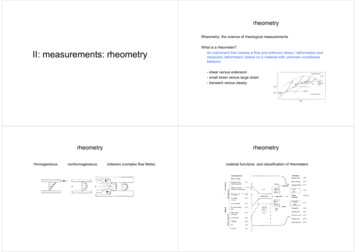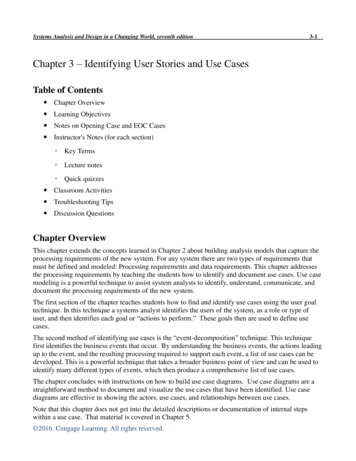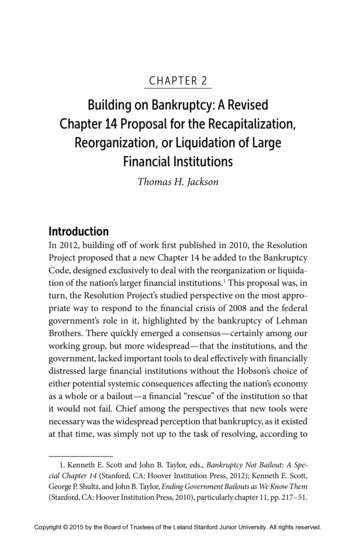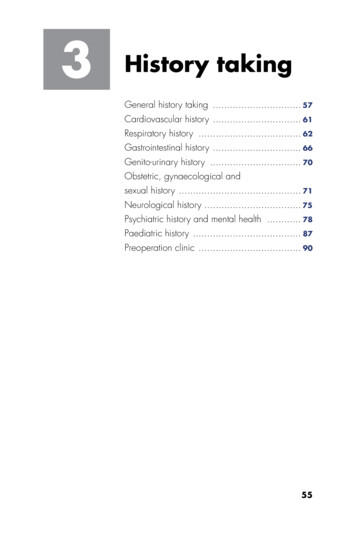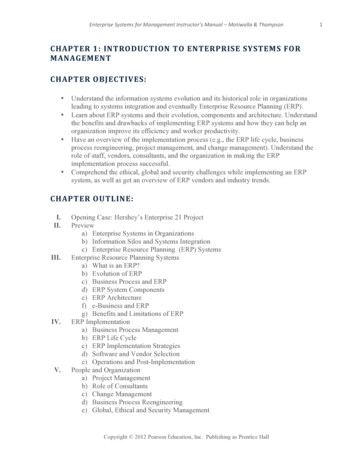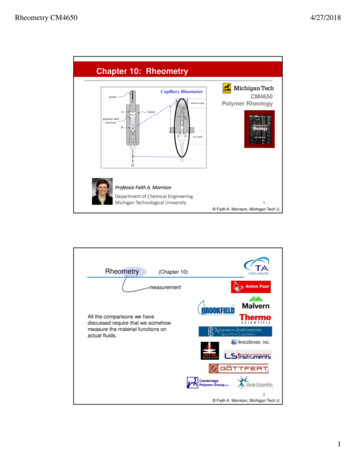
Transcription
Rheometry CM46504/27/2018Chapter 10: RheometryCapillary RheometerpistonFAentrance regionCM4650Polymer Rheologyrzbarrel2RbLpolymer meltreservoir2RBexit regionQProfessor Faith A. MorrisonDepartment of Chemical EngineeringMichigan Technological University1 Faith A. Morrison, Michigan Tech U.Rheometry(Chapter 10)measurementAll the comparisons we havediscussed require that we somehowmeasure the material functions onactual fluids.2 Faith A. Morrison, Michigan Tech U.1
Rheometry CM46504/27/2018Rheological Measurements (Rheometry) – Chapter 10Tactic: Divide the Problem in halfModeling CalculationsExperimentsDream up modelsCalculate materialfunctions frommodel stressesStandard FlowsBuild experimentalapparatuses thatallow measurementsin standard flowsCompareCalculate materialfunctions frommeasured stresses Faith A. Morrison, Michigan Tech U.Calculate modelpredictions forstresses in standardflowsRHEOMETRYPass judgmenton models3Collect models and their reportcards for future useChapter 10: RheometryCapillary RheometerpistonFAentrance regionCM4650Polymer Rheologyrzbarrel2RbLpolymer meltreservoir2RBexit regionQProfessor Faith A. MorrisonDepartment of Chemical EngineeringMichigan Technological University4 Faith A. Morrison, Michigan Tech U.2
Rheometry CM46504/27/2018Rheological Measurements (Rheometry) – Chapter 10Tactic: Divide the Problem in halfModeling CalculationsExperimentsDream up modelsCalculate modelpredictions forstresses in standardflowsRHEOMETRYStandard FlowsBuild experimentalapparatuses thatallow measurementsin standard flows Faith A. Morrison, Michigan Tech U.As with AdvancedRheology,there is way Calculate materialCalculate materialComparefunctions fromfunctions fromtoo muchhere to coverin measuredmodel stressesstressesthe time we have.Pass judgmenton models(we will be taking a tour)Collect models and their reportcards for future use5Rheological Measurements (Rheometry) – Chapter 10Thumbnail of Rheometry Need to create the flow Measure the stresses accuratelyElongation (hard) Capillary entrance losses –many assumptions Filament stretching – hard toproduce; research only Counter-rotating rolls – prettyaccessible Faith A. Morrison, Michigan Tech U.Shear (not too hard) Capillary (WeissenbergRabinowich and slip corrections,good for high ; Ψ from die swell,Ψ) Torsional flow Parallel plate (correctionneeded; low ; Ψ , Ψ ) Cone and plate (low ; can doΨ ,Ψ Couette (cup and bob; low ;Ψ ,Ψ )63
Rheometry CM46504/27/2018Rheological Measurements (Rheometry) – Chapter 10Standard Flows SummaryChoose velocity field: Symmetry of flow alone implies: 11 12 0 21 22 0 00 33 123 00 0 conHv1 ( x2 )x2x1x30 11 0 0 22 0 00 33 123 2 2x1 , x2To measure the stresses we need for materialfunctions, we must produce the defined flows7 Faith A. Morrison, Michigan Tech U.Rheological Measurements (Rheometry) – Chapter 10Simple Shear flow (Drag)(z-planesection)y 00xChallenges: Sample loading Maintain parallelism Producing linear motion Stress measurement (Edge effects) Signal strengthFrom the McGill website (2006): Hee Eon Park,first-year postdoc in Chemical Engineering,works on a high-pressure sliding plate rheometer,the only instrument of its kind in the world.J. M. Dealy and S. S. Soong “A ParallelPlate Melt Rheometer Incorporating aShear Stress Transducer,”J. Rheol. 28,355 (1984)8 Faith A. Morrison, Michigan Tech U.4
Rheometry CM46504/27/2018Rheological Measurements (Rheometry) – Chapter 10Although we stipulated simple,homogeneous shear flow be producedthroughout the flow domain, can we,perhaps, relax that requirement? 009 Faith A. Morrison, Michigan Tech U.Rheological Measurements (Rheometry) – Chapter 10Viscometric flow: motions that are locally equivalent to steady simpleshearing motion at every particle globally steady with respect to some frame of reference streamlines that are straight, circular, or helical each flow can be visualized as the relative motion of a sheaf of materialsurfaces (slip surfaces) each slip surface moves without changing shape during the motion every particle lies on a material surface that moves without stretching(inextensible slip surfaces)Viscometric Flows:1. Steady tube flow2. Steady tangential annular flow3. Steady torsional flow (parallel plate flow)4. Steady cone-and-plate flow (small cone angle)5. Steady helical flowWan-Lee Yin, Allen C. Pipkin, “Kinematics of viscometric flow,” Archive for Rational Mechanicsand Analysis, 37(2) 111-135, 1970R. B. Bird, R. Armstrong, O. Hassager, Dynamics of Polymeric Liquids, 2nd edition, Wiley(1986), section 3.7.10 Faith A. Morrison, Michigan Tech U.5
Rheometry CM46504/27/2018Rheological Measurements (Rheometry) – Chapter 10Viscometric Flows:1. Steady tube flow2. Steady tangential annular flow3. Steady torsional pp flow4. Steady cone-and-plate flow5. Steady helical flowExperimental Shear Geometries (viscometric flows)(z-planesection)y xHr(z-planesection)y rpiston( -planesection)xF( planesection)Abarrel2Rbpolymer meltreservoir( -planesection)(z-planesection)B (z-planesection)( -planesection) rQ11 Faith A. Morrison, Michigan Tech U.Rheological Measurements (Rheometry) – Chapter 10Types of Shear RheometryMechanical: Mechanically produce linear drag flow;Measure (shear strain transducer):Shear stress on a surface1.planar Couette Mechanically produce torsional drag flow;Measure: (strain-gauge; force rebalance)Torque to rotate surfacesBack out material functions1.2.3.cone and plate;parallel plate;circular Couette Produce pressure-driven flow through conduitMeasure:Pressure drop/flow rateBack out material functions1.2.capillary flowslit flow12 Faith A. Morrison, Michigan Tech U.6
Rheometry CM46504/27/2018Shear Rheometry– Capillary FlowCapillary RheometerpistonFAentrance regionrzbarrel2RbLpolymer meltreservoir2RBexit regionQ13 Faith A. Morrison, Michigan Tech U.Shear Rheometry– Capillary FlowCapillary RheometerThe basicspistonFentrance regionAbarrel2Rbpolymer meltreservoirrz2Rwell-developed flowBexit regionQ14 Faith A. Morrison, Michigan Tech U.7
Rheometry CM46504/27/2018Shear Rheometry– Capillary FlowExercise: What is the shear stress incapillary flow, for a fluid withunknown constitutive equation? What is the shear rate in capillaryflow?rz15 Faith A. Morrison, Michigan Tech U.Shear Rheometry– Capillary FlowTo calculate shear rate, shear stress, look at EOM:P p gz v v v P t steadystateunidirectional P 1 r rr 0 rr r r 1 r 2 r 0 0 2 r r 1 r P 0 rz r z z r z r r r zAssume: Incompressible fluid no -dependence long tube symmetric stress tensor Isothermal Viscosity independent of pressure16 Faith A. Morrison, Michigan Tech U.8
Rheometry CM46504/27/2018Shear Rheometry– Capillary FlowShear stress in capillary flow,for a fluid with unknownconstitutive equationShear stress in capillary flow: rz P0 PL r 2LRrR P constant z (varies with position, i.e. inhomogeneous flow)What was the shear stress in drag flow?17 Faith A. Morrison, Michigan Tech U.Shear Rheometry– Capillary FlowViscosity from capillary flow – inhomogeneous shear flowzRx2rx1Shear coordinate systemnear wall:eˆ1 eˆzeˆ2 eˆreˆ3 eˆ 21 rzr R R v z v z r R R ( r ) r wall shear stress 21 R 0 R 0 wall shear rateIt is not thesame shearrateeverywhere,but if wefocus on thewall we canstill get ( R)18 Faith A. Morrison, Michigan Tech U.9
Rheometry CM46504/27/2018Shear Rheometry– Capillary FlowViscosity from Wall Stress/Shear rateNote: we are assuming no-slip at the wallWall shear stress in capillary flow: rzr R P0 PL r2L r R PR2L P constant z What is shear rate at the wall in capillary flow?Ifis known, this is easy to calculate.19 Faith A. Morrison, Michigan Tech U.Shear Rheometry– Capillary FlowIfis known,is easy to calculate.Velocity Fields, Flow in a CapillaryNewtonian fluid:v z (r ) 2Q R 2 r 2 1 R Power-law GNF fluid:v z (r ) R1 1n11 1 P0 PL n 1 r n 1 2mL 1 n 1 R 20 Faith A. Morrison, Michigan Tech U.10
Rheometry CM46504/27/2018Shear Rheometry– Capillary FlowIfis known,is easy to calculate.Wall shear-rate for a Newtonian fluidHagen-Poiseuille:Q PR 48 L4Q 1 PR R 3 2 L a 44Q R3slope 1/ R PR2L21 Faith A. Morrison, Michigan Tech U.Shear Rheometry– Capillary FlowIfis known,is easy to calculate.Wall shear-rate for a Power-law GNF10PL-GNF flow rate:13 PR n 1 n RQ 1n 2 L m 1 3n a 44Q R31intercept 4 m 1 / n 1/ n 3 slope 1/n0.10.11 PR R 2L1022 Faith A. Morrison, Michigan Tech U.11
Rheometry CM46504/27/2018Shear Rheometry– Capillary FlowIfis known,is easy to calculate.For an unknown, non-Newtonian fluid,is not known, and weneed to take special steps to determine the wall shear rateThe wall shear rate is generally greaterthan for a Newtonian fluid.vz(r) ,R ,non NewtonianNewtonianvelocity profilenon-Newtonianvelocity profile R,, Newtonianr23 Faith A. Morrison, Michigan Tech U.Shear Rheometry– Capillary FlowIfis not known, we musttake extra steps to determine .For a General non-Newtonian fluidQ ?Somethingwall shear-rate-ish?Somethingwall shear-stress-ish24 Faith A. Morrison, Michigan Tech U.12
Rheometry CM46504/27/2018Shear Rheometry– Capillary FlowIfis not known, we musttake extra steps to determine .Weissenberg-Rabinowitsch correction410 a 134lnlnslope is afunction of R44Q R31slope d lnln aln Rd log0.10.11Shear Rheometry– Capillary Flow PR R 2L1025 Faith A. Morrison, Michigan Tech U.Other corrections for capillary flowCapillary flowAssumptions: Steady No intermittent flow allowed symmetry No spiraling flow allowed Unidirectional Check end effects Incompressible . Avoid high absolute pressures Constant pressure gradient Check end effects No slip Check wall slipMethods have been devised to account for Slip End effects26 Faith A. Morrison, Michigan Tech U.13
Rheometry CM46504/27/2018Shear Rheometry– Capillary FlowOther corrections for capillary flowSlip at the wall - Mooney analysisSlip at the wall reduces the shearrate near the wall.v1 ( x2 )v1 ( x2 )no slipx2 x1dv1dx 2slipv1, slipx2 x1dv1dx 2dv1,, smallerdx 2dv1dx 227 Faith A. Morrison, Michigan Tech U.Shear Rheometry– Capillary FlowOther corrections for capillary flowSlip at the wall - Mooney analysisv z ,av Slip at the wall reduces the shearrate near the wall.v vz ,truez , measured v z , slip44v z, ,avR4,44v z ,avR ,4Qmeasured R 34,4Q R 2 4Q a R 3,1,,slopeinterceptAt constant wallshear stress, takedata in capillariesof various RThe Mooney correction is a correction to theapparent shear rate28 Faith A. Morrison, Michigan Tech U.14
Rheometry CM46504/27/2018Shear Rheometry– Capillary FlowOther corrections for capillary flowSlip at the wall - Mooney analysis800 pR , MPa2L4Q6000.350.34v z , slip R30.250.2-1(s )0.144000.1Note: each line isat constant wallshear stress(data may needto be interpolatedto meet thisrequirement).0.050.01200Turns out there is slipsometimes!001231/R (1/mm)4Figure 10.10, p. 396 Ramamurthy,LLDPE29 Faith A. Morrison, Michigan Tech U.Shear Rheometry– Capillary FlowOther corrections for capillary flowEntrance and exit effects - Bagley correctionThe pressure gradient is notaccurately represented by the rawpressure drop:entrance regionPreservoir PatmLrz2Rwell-developed flowP(z) p L rawexit region p L correctedz 0z Lz30 Faith A. Morrison, Michigan Tech U.15
Rheometry CM46504/27/2018Shear Rheometry– Capillary FlowOther corrections for capillary flowEntrance and exit effects - Bagley correctionL PR R P 2 R 2LRentrance regionrz2RConstant atconstant Q P2 RRun fordifferentcapillarieswell-developed flowexit regionThis is theresult when theend effects arenegligible.LRThe Bagley correction is a correctionto the wall shear stress31 Faith A. Morrison, Michigan Tech U.Shear Rheometry– Capillary FlowOther corrections for capillary flowBagley Plot1200Δeffects a ( s 1 )1000Turns out that endeffects are visiblesometimes!Pressure drop (250, s )Figure 10.8, p. 394 Bagley, PE32 Faith A. Morrison, Michigan Tech U.16
Rheometry CM46504/27/2018Shear Rheometry– Capillary FlowOther corrections for capillary flow1200y 32.705x 163.53R2 0.9987 a ( s 1 )Steady State Pressure,1000250y 22.98x 107.72R2 0.999712090800y 20.172x 85.311R2 0.99986040600y 16.371x 66.018R2 0.9998400y 13.502x 36.81R2 120000102030L/RThe intercepts are equal tothe entrance/exit pressurelosses; these must besubtractedfrom the data to40get true pressure versusL/R.33Figure 10.8, p. 394 Bagley, PE Faith A. Morrison, Michigan Tech U.Shear Rheometry– Capillary FlowOther corrections for capillary flow1200 a ( s 1 )1000Steady State Pressure,y 32.705x 163.53R2 0.9987y 22.98x 107.72R2 0.9997250120800y 20.172x 85.311R2 0.9998906040600y 16.371x 66.018R2 0.9998400y 13.502x 36.81R2 1200Figure 10.8, p. 394 Bagley, PE00102030The slopes are equal totwice40the shear stress for thevarious apparent shear ratesL/R rz pR2L L p 2 rz R 34 Faith A. Morrison, Michigan Tech U.17
Rheometry CM46504/27/2018Shear Rheometry– Capillary FlowOther corrections for capillary flowThe data so far: a PentgammdotA 4036.81slopepsi32.70522.9820.17216.37113.502 R Rsh stresspsi16.352511.4910.0868.18556.751sh stressPa1.1275E 057.9220E 046.9540E 045.6437E 044.6546E 04Now, turn apparent shear rate intowall shear rate (correct for nonparabolic velocity profile).35Figure 10.8, p. 394 Bagley, PE Faith A. Morrison, Michigan Tech U.Shear Rheometry– Capillary FlowWeissenberg-Rabinowitsch correction4134lnln10slope is afunction of R4Q a 4 3 RSometimes the W
4. Steady cone-and-plate flow 5. Steady helical flow Rheological Measurements (Rheometry) – Chapter 10 Faith A. Morrison, Michigan Tech U. 12 Types of Shear Rheometry Mechanical: Mechanically produce linear drag flow; Measure (shear strain transducer): Shear stress on a surface Mechanically produce torsional drag flow;
